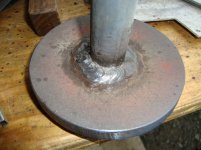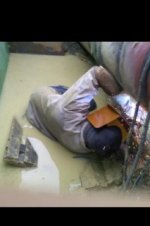Chilly807
Elite Member
I'm no expert either, but I can see a couple of things that would make me try a few changes.
I think you're a bit fast in places, which does two things. Firstly, you run at the very leading edge of the puddle, leaves larger spacing between the dimes and less deposited material. If you move a little more slowly, the puddle develops more width, which leads to better coverage at the edges of the bead. It also puts more heat into the base metal, allows the weld to penetrate better and gives a smoother looking bead.
Your electrode should travel no more than three times it's thickness on the weave motion, possibly less on a fast-freezing filler metal. My understanding is that you don't want to go back into a portion of the puddle that's already solidified unless you're "patching" a hole.
Slightly more heat will help, as will slowing down a bit. Without brushing the slag off the toes of the weld it's hard to see how much fusion you're getting out there. It looks a little cold at the edges.
The first pic was 1/8 7018, the extra heat smooths out the distinct ripples, flattens the weld slightly, and smooths out the toes so they blend into the base metal. As I recall it was a fairly slow weld too.
The second pic was mig, not really much comparison to the first, but the appearance is easier to see. Flat toes, not much ripple to it, I think it was more of a straight bead than a weave. Not happy with the amount of spatter I had, and you can tell my vertical welding technique needs work.
I find that after using the stick for a while, I'm shocked at how much ground I can cover with the mig. If I use the same travel speed I'm piling the weld up too much. I think that's part of what gives the stick such good penetration, the travel is slower which allows more heat buildup and better (deeper) fusion.
I can weld a job up in half the time it takes me with the stick. Not including chipping and brushing slag.
Each has their place, I normally use the stick about twice to three times as much as I use the mig now.
Try running practice beads until you don't see improvement, then give it up for the day. I find the single most important things (once you have the heat right) are travel speed and puddle manipulation. You can steer the puddle where you want it, and control it's extent and shape by what you do with the rod.
Sound is often your best secondary indication of arc length. It tells you something's changed, like a warning chime.
I try to picture burning the rod over the length of the weld area before I strike the arc. Think about the angle your hand is going to have to maintain, how much slack you have in the weld cable, and if you have room to move the holder toward the workpiece as the rod gets shorter. As you get more experience it'll become second nature.
I find once I strike the arc, things happen faster than I'd like. Too much to think about all at once. If you plan the bead before you start it gets easier. Slow motion welding would be nice!
Like I said at the start, I'm no pro when it comes to welding. I didn't post all the ugly bead pics!!
I've seen a lot worse than what you have there, and have done much worse myself.
Sean
I think you're a bit fast in places, which does two things. Firstly, you run at the very leading edge of the puddle, leaves larger spacing between the dimes and less deposited material. If you move a little more slowly, the puddle develops more width, which leads to better coverage at the edges of the bead. It also puts more heat into the base metal, allows the weld to penetrate better and gives a smoother looking bead.
Your electrode should travel no more than three times it's thickness on the weave motion, possibly less on a fast-freezing filler metal. My understanding is that you don't want to go back into a portion of the puddle that's already solidified unless you're "patching" a hole.
Slightly more heat will help, as will slowing down a bit. Without brushing the slag off the toes of the weld it's hard to see how much fusion you're getting out there. It looks a little cold at the edges.
The first pic was 1/8 7018, the extra heat smooths out the distinct ripples, flattens the weld slightly, and smooths out the toes so they blend into the base metal. As I recall it was a fairly slow weld too.
The second pic was mig, not really much comparison to the first, but the appearance is easier to see. Flat toes, not much ripple to it, I think it was more of a straight bead than a weave. Not happy with the amount of spatter I had, and you can tell my vertical welding technique needs work.
I find that after using the stick for a while, I'm shocked at how much ground I can cover with the mig. If I use the same travel speed I'm piling the weld up too much. I think that's part of what gives the stick such good penetration, the travel is slower which allows more heat buildup and better (deeper) fusion.
I can weld a job up in half the time it takes me with the stick. Not including chipping and brushing slag.
Each has their place, I normally use the stick about twice to three times as much as I use the mig now.
Try running practice beads until you don't see improvement, then give it up for the day. I find the single most important things (once you have the heat right) are travel speed and puddle manipulation. You can steer the puddle where you want it, and control it's extent and shape by what you do with the rod.
Sound is often your best secondary indication of arc length. It tells you something's changed, like a warning chime.
I try to picture burning the rod over the length of the weld area before I strike the arc. Think about the angle your hand is going to have to maintain, how much slack you have in the weld cable, and if you have room to move the holder toward the workpiece as the rod gets shorter. As you get more experience it'll become second nature.
I find once I strike the arc, things happen faster than I'd like. Too much to think about all at once. If you plan the bead before you start it gets easier. Slow motion welding would be nice!
Like I said at the start, I'm no pro when it comes to welding. I didn't post all the ugly bead pics!!
I've seen a lot worse than what you have there, and have done much worse myself.
Sean



